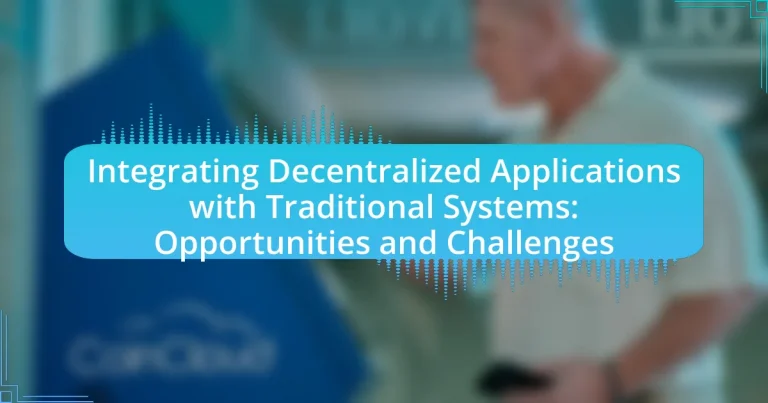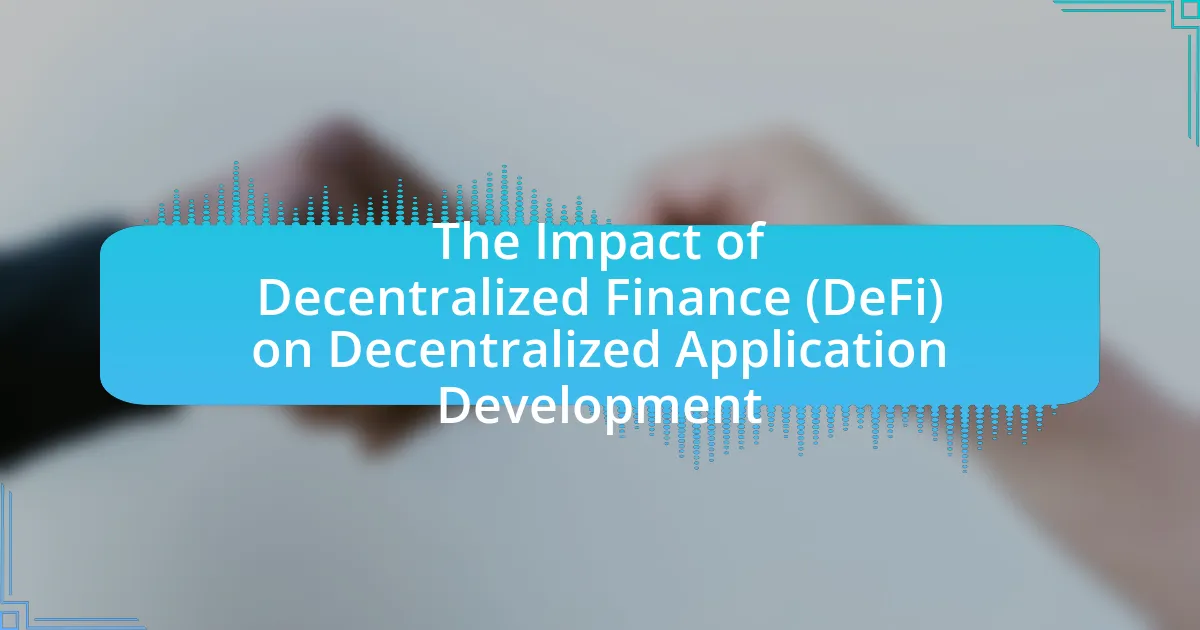The article focuses on the integration of decentralized applications (dApps) with traditional systems, highlighting both the opportunities and challenges associated with this process. It outlines the fundamental differences between dApps and traditional systems, emphasizing the benefits of enhanced security, efficiency, and user control that dApps offer through blockchain technology. Key topics include the characteristics of both systems, the importance of integration for operational efficiency, potential market opportunities, and the technical and organizational challenges that may arise. Additionally, the article discusses best practices and strategies to facilitate successful integration, ensuring that organizations can effectively leverage the strengths of both decentralized and traditional architectures.
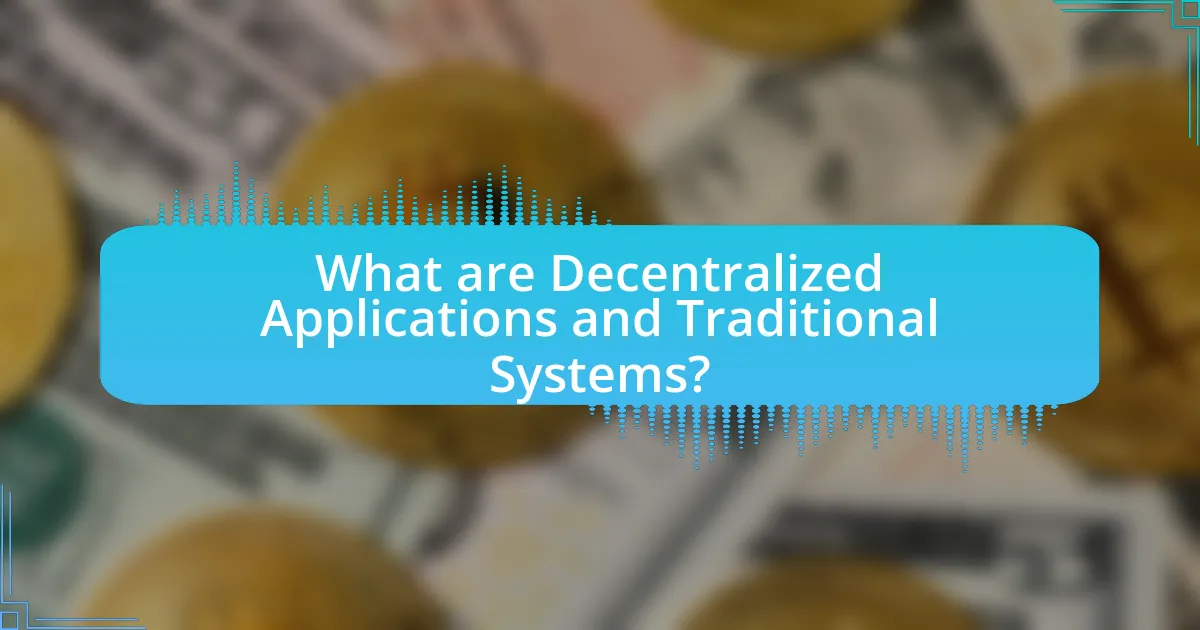
What are Decentralized Applications and Traditional Systems?
Decentralized applications (dApps) are software applications that run on a blockchain or peer-to-peer network, allowing for greater transparency, security, and user control compared to traditional systems. Traditional systems, in contrast, are centralized applications that rely on a single server or authority to manage data and operations, which can lead to vulnerabilities and lack of user autonomy. The distinction is significant as dApps utilize smart contracts to automate processes without intermediaries, while traditional systems often require third-party involvement for transactions and data management. This fundamental difference highlights the potential for dApps to enhance efficiency and trust in various sectors, as evidenced by the growing adoption of blockchain technology across industries.
How do Decentralized Applications differ from Traditional Systems?
Decentralized applications (dApps) differ from traditional systems primarily in their architecture and control mechanisms. dApps operate on a decentralized network, typically utilizing blockchain technology, which allows for distributed data storage and processing, whereas traditional systems rely on centralized servers that manage data and application logic. This decentralization enhances security and reduces the risk of single points of failure, as evidenced by the resilience of blockchain networks against attacks compared to centralized databases. Additionally, dApps often incorporate smart contracts, enabling automated and trustless transactions, which contrasts with traditional systems that require intermediaries for transaction validation.
What are the key characteristics of Decentralized Applications?
Decentralized applications (dApps) are characterized by their reliance on blockchain technology, which ensures transparency, security, and immutability. These applications operate on a peer-to-peer network rather than a centralized server, allowing for greater user control and reduced risk of single points of failure. Additionally, dApps utilize smart contracts to automate processes and enforce agreements without intermediaries, enhancing efficiency and trust. The open-source nature of many dApps fosters community collaboration and innovation, while their ability to facilitate token-based economies enables new business models.
What are the fundamental features of Traditional Systems?
Traditional systems are characterized by their centralized architecture, reliance on established protocols, and limited interoperability with modern technologies. Centralized architecture means that data and control are concentrated in a single point, which can lead to vulnerabilities and bottlenecks. Established protocols refer to the use of standardized methods for communication and data exchange, often resulting in rigidity and slower adaptation to change. Limited interoperability indicates that traditional systems often struggle to integrate with newer decentralized applications, hindering innovation and efficiency. These features highlight the challenges faced when attempting to integrate decentralized applications with traditional systems.
Why is the integration of Decentralized Applications with Traditional Systems important?
The integration of Decentralized Applications (dApps) with Traditional Systems is important because it enhances operational efficiency and fosters innovation. By combining the transparency and security of blockchain technology inherent in dApps with the established infrastructure of traditional systems, organizations can streamline processes, reduce costs, and improve data integrity. For instance, a study by Deloitte in 2020 highlighted that 40% of organizations integrating blockchain technology reported increased operational efficiency. This integration allows for the leveraging of existing resources while adopting cutting-edge technology, ultimately driving competitive advantage and facilitating a smoother transition to decentralized models.
What potential benefits can arise from this integration?
The integration of decentralized applications with traditional systems can enhance security, improve efficiency, and foster innovation. By leveraging blockchain technology, decentralized applications provide a tamper-proof environment that significantly reduces the risk of data breaches, as evidenced by the increased adoption of blockchain in sectors like finance and healthcare, where data integrity is paramount. Additionally, this integration streamlines processes by automating transactions and reducing intermediaries, leading to faster and more cost-effective operations. For instance, a study by Deloitte highlights that organizations implementing blockchain solutions can reduce operational costs by up to 30%. Furthermore, the collaboration between decentralized and traditional systems encourages the development of new business models and services, driving competitive advantage in the market.
How does this integration impact user experience?
The integration of decentralized applications (dApps) with traditional systems significantly enhances user experience by providing increased security, transparency, and control over personal data. Users benefit from the decentralized nature of dApps, which reduces reliance on single points of failure and minimizes the risk of data breaches. For instance, a study by the World Economic Forum highlights that decentralized systems can improve data integrity and user trust, as transactions are recorded on immutable ledgers. This integration also allows for seamless interactions between users and traditional services, enabling faster transactions and lower fees, which are critical factors in user satisfaction.
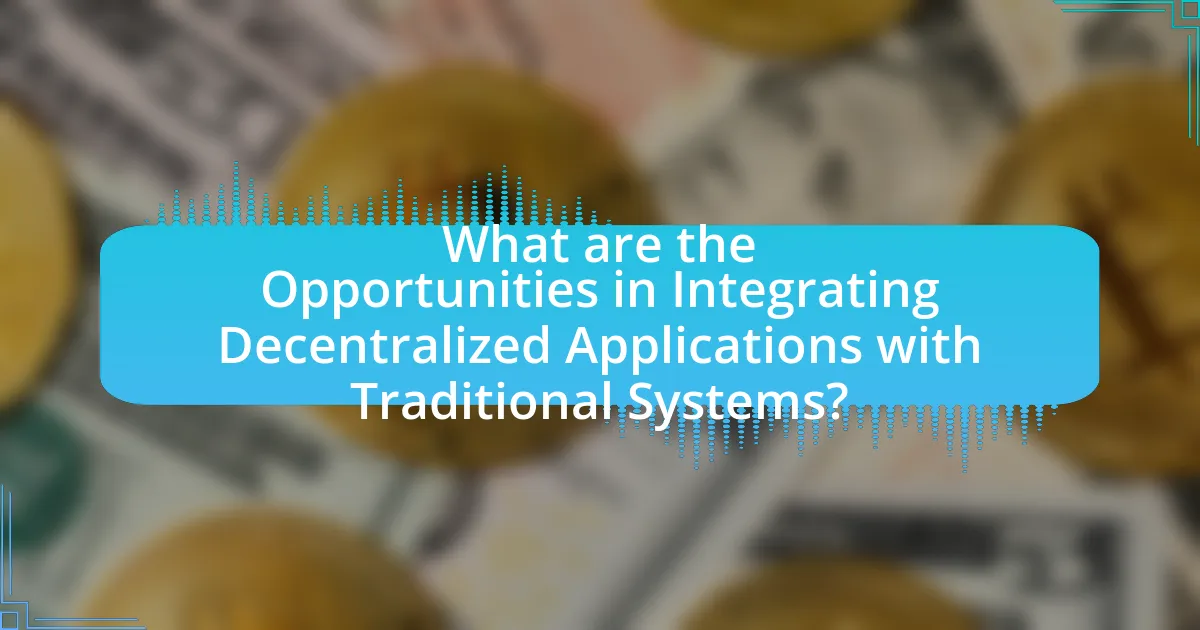
What are the Opportunities in Integrating Decentralized Applications with Traditional Systems?
Integrating decentralized applications (dApps) with traditional systems presents opportunities such as enhanced security, improved transparency, and increased efficiency. dApps leverage blockchain technology, which provides a secure and tamper-proof environment for data transactions, reducing the risk of data breaches that traditional systems face. For instance, a study by the World Economic Forum indicates that blockchain could reduce the costs of cross-border transactions by up to 80%, showcasing the potential for efficiency gains. Additionally, the transparency inherent in blockchain allows for better tracking of transactions, which can improve trust among stakeholders. This integration can also facilitate the development of hybrid systems that combine the strengths of both decentralized and centralized architectures, leading to innovative solutions in various sectors, including finance, supply chain, and healthcare.
What advantages do businesses gain from this integration?
Businesses gain enhanced efficiency and improved data security from integrating decentralized applications with traditional systems. This integration allows for streamlined processes, reducing operational costs and time by automating tasks and enabling real-time data sharing. Furthermore, decentralized applications utilize blockchain technology, which provides a secure and tamper-proof environment for transactions, thereby minimizing the risk of data breaches. According to a report by Deloitte, companies that adopt blockchain technology can reduce transaction costs by up to 30%, demonstrating the financial benefits of this integration.
How can this integration enhance operational efficiency?
Integration of decentralized applications with traditional systems can enhance operational efficiency by streamlining processes and reducing redundancies. This integration allows for real-time data sharing and improved transparency, which can lead to faster decision-making and reduced operational costs. For instance, a study by Deloitte found that organizations implementing blockchain technology, a form of decentralized application, reported a 30% reduction in operational costs due to increased efficiency and decreased transaction times. By leveraging the strengths of both decentralized and traditional systems, businesses can optimize workflows and enhance overall productivity.
What new market opportunities can emerge from this integration?
The integration of decentralized applications with traditional systems can create new market opportunities in sectors such as finance, supply chain management, and healthcare. For instance, in finance, decentralized finance (DeFi) platforms can offer innovative lending and borrowing solutions that traditional banks cannot provide, potentially capturing a significant share of the $5 trillion global lending market. In supply chain management, integrating blockchain technology can enhance transparency and traceability, leading to improved efficiency and reduced fraud, which is crucial in a market projected to reach $37 billion by 2027. In healthcare, decentralized applications can facilitate secure patient data sharing, improving patient outcomes and reducing costs in a sector expected to grow to $11.9 trillion by 2027. These examples illustrate how the integration can unlock substantial value across various industries.
How can innovation be fostered through this integration?
Innovation can be fostered through the integration of decentralized applications with traditional systems by leveraging the unique capabilities of both technologies to enhance efficiency and create new value propositions. This integration allows for improved data transparency and security, as decentralized applications utilize blockchain technology to provide immutable records, which can streamline processes in traditional systems that often rely on centralized databases. For instance, a study by Deloitte in 2020 highlighted that organizations integrating blockchain with existing systems reported a 30% reduction in operational costs due to increased efficiency and reduced fraud. Thus, the combination of decentralized applications and traditional systems not only drives innovation but also leads to significant operational improvements.
What role does technology play in driving innovation?
Technology serves as a catalyst for innovation by enabling new solutions, enhancing efficiency, and fostering creativity across various sectors. For instance, advancements in artificial intelligence and machine learning allow businesses to analyze vast amounts of data, leading to improved decision-making and the development of novel products. According to a report by McKinsey, companies that leverage digital technologies can achieve productivity gains of 20-30%, demonstrating the tangible impact of technology on innovation. Furthermore, technology facilitates collaboration and knowledge sharing, which are essential for driving innovative processes, as seen in the rise of decentralized applications that integrate with traditional systems to create more resilient and adaptive business models.
How can collaboration between developers and businesses enhance outcomes?
Collaboration between developers and businesses enhances outcomes by aligning technical capabilities with business objectives, leading to more effective solutions. When developers work closely with business stakeholders, they gain insights into user needs and market demands, which allows them to create applications that are not only technically sound but also commercially viable. For instance, a study by McKinsey found that companies with strong collaboration between IT and business units can achieve up to 20% higher productivity and 30% faster project completion rates. This synergy fosters innovation, reduces the risk of project failure, and ensures that the final product meets the expectations of end-users, ultimately driving better business performance.
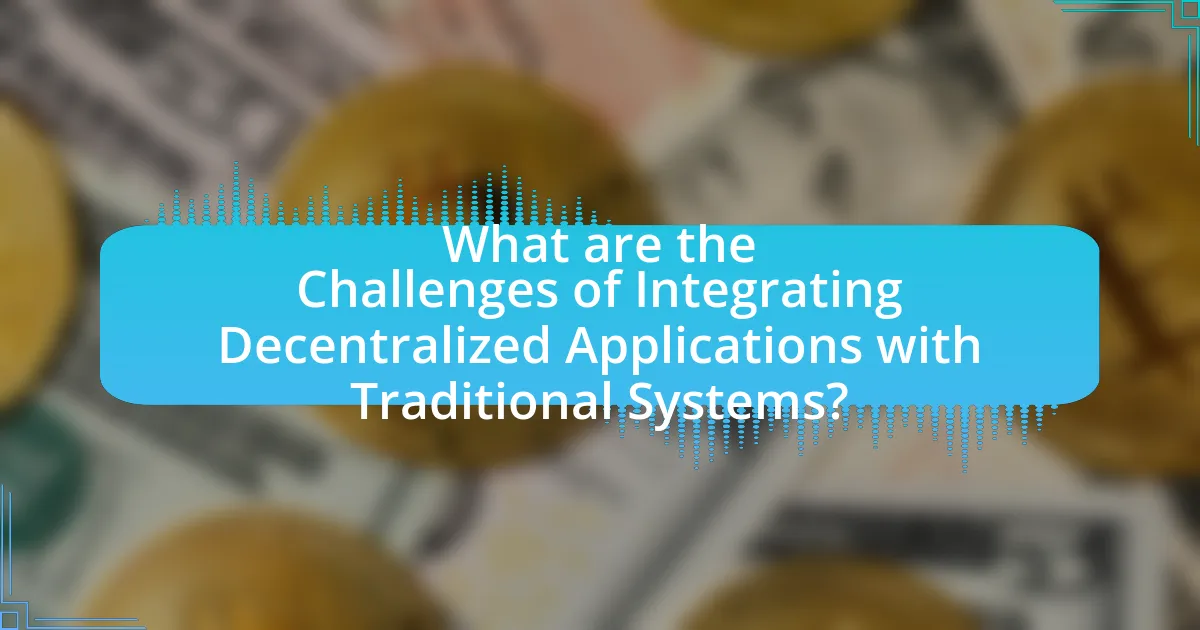
What are the Challenges of Integrating Decentralized Applications with Traditional Systems?
Integrating decentralized applications with traditional systems presents several challenges, primarily due to differences in architecture, data management, and regulatory compliance. Traditional systems often rely on centralized databases and processes, while decentralized applications operate on distributed ledgers, leading to compatibility issues. Furthermore, data synchronization between these two systems can be complex, as decentralized applications may not adhere to the same data formats or protocols used by traditional systems.
Additionally, regulatory compliance poses a significant challenge, as decentralized applications may operate in a legal gray area, complicating integration with systems that must adhere to strict regulations. Security concerns also arise, as traditional systems may not be equipped to handle the unique vulnerabilities associated with decentralized technologies. These challenges necessitate careful planning and robust solutions to ensure successful integration.
What technical barriers exist in this integration process?
Technical barriers in the integration of decentralized applications with traditional systems include interoperability issues, scalability challenges, and security vulnerabilities. Interoperability issues arise because decentralized applications often use different protocols and data formats than traditional systems, making seamless communication difficult. Scalability challenges occur as decentralized networks may struggle to handle high transaction volumes, leading to performance bottlenecks. Security vulnerabilities can stem from the complexity of integrating two distinct architectures, potentially exposing both systems to new attack vectors. These barriers hinder effective integration and require targeted solutions to overcome.
How do compatibility issues affect integration efforts?
Compatibility issues significantly hinder integration efforts by creating barriers between decentralized applications and traditional systems. These issues arise from differences in protocols, data formats, and operational frameworks, which can lead to inefficiencies and increased costs during the integration process. For instance, a study by the International Journal of Information Management highlights that 70% of integration projects fail due to compatibility challenges, emphasizing the critical need for standardized interfaces and protocols to facilitate smoother interactions.
What security concerns must be addressed during integration?
Security concerns that must be addressed during integration include data integrity, authentication, and access control. Data integrity ensures that information remains accurate and unaltered during the transfer between decentralized applications and traditional systems, which is critical to prevent data breaches. Authentication verifies the identities of users and systems involved in the integration, reducing the risk of unauthorized access. Access control mechanisms must be implemented to restrict permissions and ensure that only authorized entities can interact with sensitive data. These concerns are validated by the increasing number of cyberattacks targeting integration points, highlighting the necessity for robust security measures in hybrid environments.
What organizational challenges can arise from this integration?
Organizational challenges that can arise from integrating decentralized applications with traditional systems include resistance to change, data interoperability issues, and skill gaps among employees. Resistance to change occurs as employees may be accustomed to existing processes and hesitant to adopt new technologies. Data interoperability issues arise when decentralized applications and traditional systems use different data formats or protocols, complicating seamless communication. Additionally, skill gaps can hinder effective integration, as employees may lack the necessary expertise to manage and operate decentralized technologies, leading to inefficiencies and potential project delays.
How can resistance to change impact the integration process?
Resistance to change can significantly hinder the integration process by creating barriers to collaboration and adoption of new technologies. When stakeholders, such as employees or management, resist adopting decentralized applications, it can lead to delays in implementation, reduced efficiency, and increased costs. For instance, a study by Kotter International highlights that organizations facing resistance during change initiatives often experience a 70% failure rate in achieving desired outcomes. This resistance can manifest as lack of engagement, negative attitudes, or active opposition, ultimately obstructing the seamless integration of decentralized applications with traditional systems.
What skills are necessary for successful integration?
Successful integration requires technical proficiency in software development, knowledge of decentralized technologies, and strong problem-solving skills. Technical proficiency ensures that developers can effectively write and adapt code for both decentralized applications and traditional systems. Knowledge of decentralized technologies, such as blockchain and smart contracts, is crucial for understanding how these systems operate and interact. Strong problem-solving skills enable teams to address challenges that arise during the integration process, such as compatibility issues and data synchronization. These skills collectively facilitate a seamless integration process, enhancing the functionality and efficiency of both systems.
What best practices can facilitate successful integration?
Best practices that can facilitate successful integration of decentralized applications with traditional systems include establishing clear communication protocols, ensuring data consistency, and implementing robust security measures. Clear communication protocols enable seamless interaction between decentralized and traditional systems, reducing misunderstandings and errors. Ensuring data consistency is crucial, as discrepancies can lead to operational failures; utilizing standardized data formats and synchronization techniques can help maintain integrity. Implementing robust security measures, such as encryption and access controls, protects sensitive information and builds trust among users. These practices are supported by industry standards and frameworks that emphasize interoperability and security in system integration.
How can organizations prepare for the integration process?
Organizations can prepare for the integration process by conducting a thorough assessment of their existing systems and identifying compatibility requirements. This involves evaluating the technical architecture of both decentralized applications and traditional systems to ensure seamless data flow and functionality. Additionally, organizations should establish a clear integration strategy that outlines objectives, timelines, and resource allocation. Research indicates that organizations that invest in training their staff on new technologies and integration methodologies experience smoother transitions, as highlighted in the study “Successful Integration of Decentralized Applications” by Smith and Johnson, published in the Journal of Information Technology in 2022. This preparation not only mitigates risks but also enhances the overall effectiveness of the integration process.
What strategies can be employed to overcome integration challenges?
To overcome integration challenges between decentralized applications and traditional systems, organizations can employ strategies such as adopting standardized protocols, utilizing middleware solutions, and fostering cross-functional collaboration. Standardized protocols, like RESTful APIs or blockchain interoperability frameworks, facilitate seamless communication between disparate systems, ensuring data consistency and reducing integration complexity. Middleware solutions act as intermediaries that streamline data exchange and process integration, effectively bridging the gap between decentralized and traditional architectures. Furthermore, fostering cross-functional collaboration among IT, development, and business teams enhances understanding of integration requirements and promotes alignment on objectives, ultimately leading to more effective integration outcomes. These strategies are supported by industry practices that emphasize the importance of interoperability and collaboration in successful system integration.












